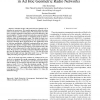155
click to vote
JMLR
2012
13 years 3 months ago
2012
We prove logarithmic regret bounds that depend on the loss L∗ T of the competitor rather than on the number T of time steps. In the general online convex optimization setting, o...
149
Voted
VRIPHYS
2010
14 years 7 months ago
2010
We present a novel boundary handling scheme for incompressible fluids based on Smoothed Particle Hydrodynamics (SPH). In combination with the predictive-corrective incompressible ...
100
click to vote
CORR
2007
Springer
15 years 22 days ago
2007
Springer
We present the results of gravitational direct N-body simulations using the commercial graphics processing units (GPU) NVIDIA Quadro FX1400 and GeForce 8800GTX, and compare the re...
ESANN
2006
15 years 2 months ago
2006
Abstract. We present experimental results about learning function values (i.e. Bellman values) in stochastic dynamic programming (SDP). All results come from openDP (opendp.sourcef...
103
click to vote
COCO
2010
Springer
15 years 4 months ago
2010
Springer
Abstract—We consider two natural extensions of the communication complexity model that are inspired by distributed computing. In both models, two parties are equipped with synchr...
94
Voted
BMAS
2000
IEEE
15 years 5 months ago
2000
IEEE
Analog simulators typically use a dynamic, adaptive time step control strategy in order to minimize the calculations performed during inactive portions of a system’s operation, ...
119
click to vote
PG
2002
IEEE
15 years 5 months ago
2002
IEEE
This paper presents a set of feature enhancement techniques coupled with hardware-accelerated nonphotorealistic rendering for generating more perceptually effective visualizations...
100
Voted
WONS
2005
IEEE
15 years 6 months ago
2005
IEEE
—Wireless ad hoc radio networks have gained a lot of attention in recent years. We consider geometric networks, where nodes are located in a euclidean plane. We assume that each ...
116
click to vote
ICRA
2005
IEEE
15 years 6 months ago
2005
IEEE
- Stable and effective enforcement of hard constraints is one of the crucial components in controlling physics-based dynamic simulation systems. The conventional explicit Baumgarte...
143
click to vote
VIS
2004
IEEE
16 years 1 months ago
2004
IEEE
Typically there is a high coherence in data values between neighboring time steps in an iterative scientific software simulation; this characteristic similarly contributes to a co...

